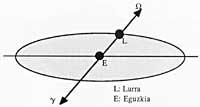Back against astrology
1995/03/01 Arregi Bengoa, Jesus Iturria: Elhuyar aldizkaria
Germanic astronomer Johann Kepler lived between 1571 and 1630 after the Renaissance in the 16th century. in the second half of the seventeenth century. During the 20th century it took place in the context of the scientific revolution. He is one of the founders of modern astronomy. He was a mathematician in the state of Gratz and one of his tasks in this profession was Judicial Astrology. He also published the astrological calendar. We know, however, that he did not do it because he liked everything or because he believed in correcting the consequences he could achieve on the path of astrology, but because it was a simpler way of life than astronomy. Unfortunately I don't think the situation has changed substantially.
J. In addition to Kepler, most contemporary astronomers, E. Brahe (1546-1601) his master and G. The Galiles (1564-1642), among them, produced horoscopes. However, there is an important difference between Brahe and Kepler and Galileo, the former did not accept N. The heliocentric system was proposed by Copernicus (1473-1543), K. He accepted the geocentric model of Ptolemy. However, the superiority of the heliocentric models over the other had a lot to do when astronomers ruled out astrology. Astrologers had to accept the falsehood of the universe model they used. However, they did nothing more than small changes to continue like this.
We know, then, when astronomy and astrology began to differentiate and move away. Since then, as astronomy has developed, many new arguments have been launched against astrology, but apparently they have not managed to reduce the number of customers. But let us mention some of these arguments.
The discoveries of Uranus, Neptune and Pluto generated a new problem in Astrology. The same could be said of asteroids, which in the end also move like planets and like planets, asteroids can also cause some effect. It would be a very curious problem if someone was born at one of the poles, from where half of the zodiac signs are always visible and the other half always hidden.
What then is the influence of ascent and ignorance? We have similar problems not only in the poles, but also in the polar circles. The precession of the equinoxes is no less. When Ptolemy built the astrological system, in early spring the Sun entered the constellation of Aries. At present, due to the precipitation mentioned, in the spring equinox the Sun enters Pisces, so those who have traditionally been considered as Aries should be Pisces, and so we would all be the ones we have considered previous.
The final scandal of this long debate between astronomers and astrologers was triggered last January. Limits of cause constellations XX. It is not a well-defined century. After 2,000 years in peace in Ortzia, the Ophinchus has not brought little news, since many people should change signs. The organization of the stars of the sky, whether or not in the zodiac, is totally arbitrary in the constellations, as the arbitrary selection of stars that can influence the nature of the human being and the field of influence that adapts to each of them is also arbitrary. I believe that arbitrariness is the most prominent feature of astrology and that is why I believe that no conclusive conclusions can be reached.
The end, like the beginning, with Kepler, would say that “it is evident that heaven influences the human being, but it is unknown what it materializes.”

Gai honi buruzko eduki gehiago
Elhuyarrek garatutako teknologia






